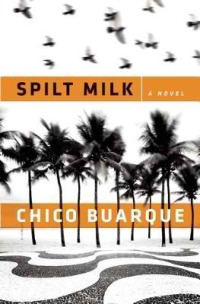The Shape of Bones by Daniel Galera
 Monday, October 9, 2017 at 10:16AM
Monday, October 9, 2017 at 10:16AM 
First published in Brazil in 2006; published in translation by Penguin Press on August 15, 2017
The Shape of Bones reads like a collection of related stories that follow a group of characters in Brazil, but the stories eventually shape themselves into a novel. Each episode/chapter has a title and most can be read as a discrete story. Each is narrated by Hermano. The developing story in the present interweaves with memories of Hermano’s past.
The episodes in the past are set in Esplanada, a city in Northeast Brazil. They give shape to Hermano’s life. For example, “The Urban Cyclist” is Hermano as a ten-year-old boy who rides his bicycle at high speeds on the tricky pavements of suburban streets. The story tells of Hermano’s encounter with an old woman who explains the blood that is spilling from his knee after a tumble. Other cycling stories make clear that Hermano craves attention and is jealous of friends who receive more accolades than he can manage. The memories serve to establish Hermano’s character and to fix the city of Esplanada firmly in the reader’s mind.
Hermano’s memories of the past involve the people he hung with, the ones he liked and those he regarded as threats. The first story that features Bonobo is about a collision and its dangerous repercussions on a soccer field. In later memories, Bonobo becomes an important (but not well liked) figure in Hermano’s life, someone Hermano envies for the wrong reasons. Bonobo is eventually involved in the key dramatic moment that defines Hermano’s past, a moment that changes to suit Hermano as he retells it.
Other episodes reveal additional stages of Hermano’s life. In one, we see Hermano’s high school insecurity as he attends a girl’s birthday party, unsure whether he wants to dance, hesitant to make eye contact with girls, unable to intervene when another boy at the party is giving a girl a hard time. Cowardice is a recurring theme.
In the present, we discover that Hermano is a cosmetic surgeon, married with child, the completion of a goal-driven life. Most of the episodes set in the present take place minutes apart from each other. They tell of Hermano’s plan to join his friend Renan on an expedition to climb a mountain that has never been climbed. Each episode is titled with a time (such as “6:08 a.m.”) and each is told in long paragraph, which I imagine is meant to give them a sense of onrushing immediacy. That doesn’t work very well, since the content is often too contemplative to justify the form.
How are we to understand Hermano? I’m not sure we can, because Hermano does not understand why he has suddenly chosen to become “a solitary renegade deserting all ties to his life to seek something in his origins.” He has made a sudden, fateful and impulsive decision that will change his life for no obvious purpose. He is a quixotic character, perhaps in the grip of self-delusion. He briefly fancies himself a hero although he’s really kind of a dick. But maybe he’s just changing in a belated reaction to the dramatic moment that took place fifteen years earlier. The past always catches up to the present no matter how quickly we try to run from it, and that might be the ultimate point of The Shape of Bones.
RECOMMENDED

